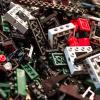Sign in to follow this
Followers
0

PF powered steam tank engine
By
Dutchiedoughnut, in LEGO Train Tech
-
Recently Browsing 0 members
No registered users viewing this page.

By
Dutchiedoughnut, in LEGO Train Tech
No registered users viewing this page.